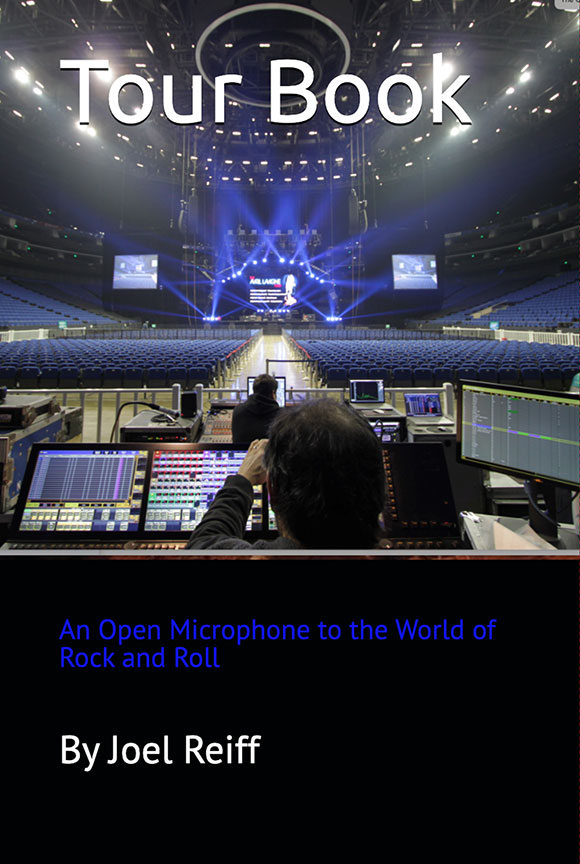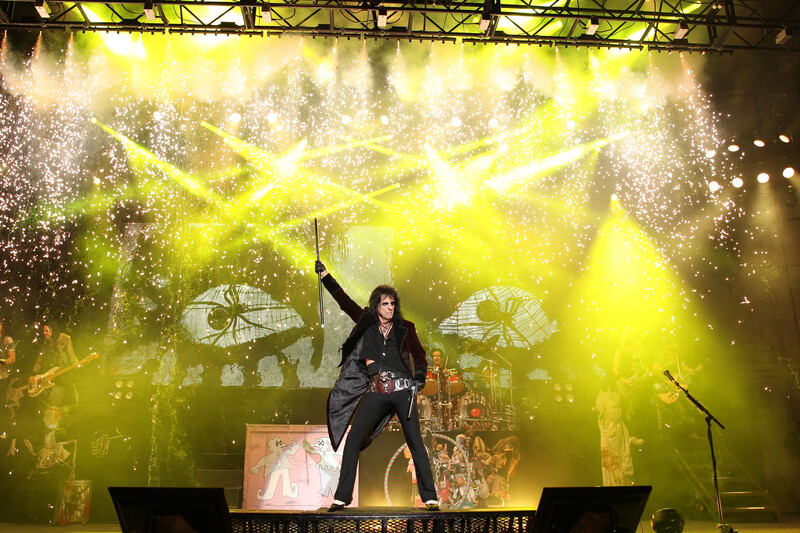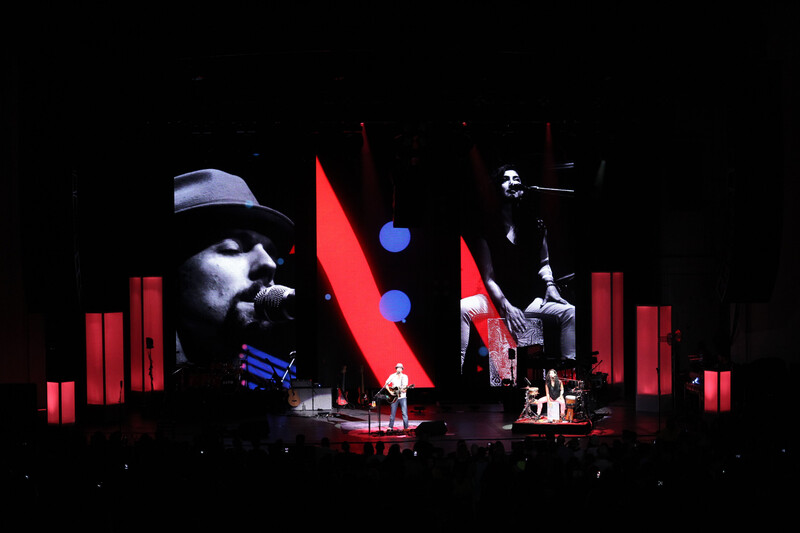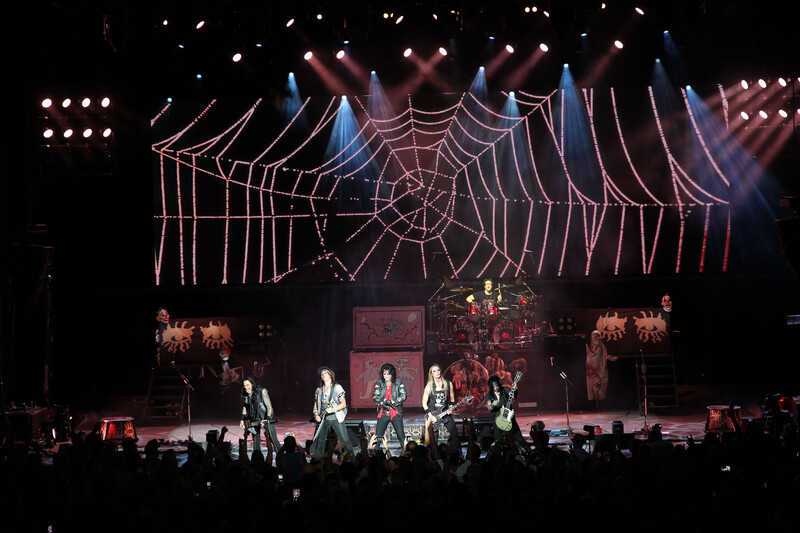Joel Reiff – Intuitive Light
Posted on November 2, 2021
Photo: Todd Kaplan
“I never made one of my discoveries through the process of rational thinking,” wrote Albert Einstein when discoursing on the role of intuition in science. It’s a sentiment that this South Carolina-based LD has readily identified with when lighting a litany of stars like Alice Cooper, 50 Cent, Godsmack, and others over the course of his 35-year career.
It’s not that Reiff is unaccustomed to rational thinking, he holds a BA in Finance and has authored several novels, but when sitting at a console, he is intently attuned to the vibes that surround him.
 How intensely is the music being performed on a given evening? How are the band members interacting with one another? What is the mood of the crowd? Sensations like these, indefinable and invisible, but oh so real, as they float through the arena, will influence how he executes his lighting plan.
How intensely is the music being performed on a given evening? How are the band members interacting with one another? What is the mood of the crowd? Sensations like these, indefinable and invisible, but oh so real, as they float through the arena, will influence how he executes his lighting plan.
This fine-tuned sensitivity has made Reiff a much-in-demand LD for artists of every stripe. It has also helped him forge solid long term relationships like the one he enjoys with Jason Mraz, who he has been lighting for over a decade. Others on his long and varied list of clients include, Neil Young, Korn, Bob Dylan, Avril Lavigne, Live, They Might Be Giants and Dresden Dolls.
Speaking to us from the studio at his company Lighten Up & Design, Reiff shared insights into the power of intuitive light.
You’ve lit some very famous storytelling artists like Bob Dylan. How does that compare to lighting more hard-driving rock artists like Korn?
“It’s always a bonus to light music that you like. I was a fan of Bob’s older material, so initially it was a thrill. However, no one can butcher a Dylan song quite like Bob. He always has a smoking hot band, so that’s cool. I never really cared for Bob’s performances during the three-plus years I was working for him.

Photo: Todd Kaplan
“To be honest, lighting it was a bit mundane. You didn’t get to flex your lighting wings too much. That was fine. I don’t think the tail should wag the dog, so the lighting shouldn’t be flashy if the music doesn’t call for it.
“With Dylan, I pretty much set up a scene and let them play. Korn is completely different. Though I’ve never been a fan of their music, they were a blast to light. The songs are so frenetic they beg for continual flash and trash. I had to devise ways to make twenty sections of strobing different as it fit so many songs! Even with music you don’t like, you grab onto something that attracts you. With Korn, I was able to really push the eye candy.”
Based on what you just said about Korn, is it fair to assume that you don’t have to like an artist’s music to do a good job lighting it?
“True, you don’t have to like a band’s music to light it, but it helps. I lit 50 Cent, care of my friend Alex Skowron, for a while. I’m not a rap fan. You find something to connect with and run with it. With 50, it was the beat. I try not to stand in the way of the artist. People should be able to get into the music, and I try to use lighting to facilitate that.”

Photo: Todd Kaplan
Are artists more involved in their lightshows today, than they were when you started three decades ago?
“I don’t think so. There are artists who will have their own ideas about a song. I remember Peter Frampton once asking about what colors I use for a certain song. After I told him, he thought about it for a moment, then said something to the effect of, ‘I kind of see it as a red and blue song. That’s what it was to me when I wrote it.’ Done. I changed it the next day. It’s his song. Doesn’t matter if I think my colors worked better in my eyes, the song is his.”
So, is there any artist who stands as being the most attuned to lighting?
“Sully Erna from Godsmack! He once told me that he probably would have become a LD if he didn’t become a rock star; and he said this with no pomposity. I love working with him because he has definite ideas about certain songs — he just doesn’t know how to program the console to do it. That’s where I come in. There were many times he’d come in for soundcheck and end up at the lighting console with me for an hour to work on something he wanted. His ideas were great. I could get my two bits in by showing him all kinds of options based on his ideas, and we’d go back and forth until he got/saw on the stage what was in his mind’s eye.
“However, this is the exception. Most artists don’t have a clue about what we LDs do. Everyone is a back-seat soundman, so I’m usually off the hook. Of the handful that are interested in lighting , a good percentage of them don’t want to invest the time. Hopefully, I’m hired because the artist heard good things and has confidence in what I bring to the table. Or, maybe they’re just so desperate they figure it can’t be any worse than what they had in the past!”

Photo: Todd Kaplan
We know you’re guided by the music when you busk a show, but are there other factors that influence what you do on the console during a show, such as the reaction of the crowd? How about the mood of the band on stage?
“Most definitely both of those things. I love what I do because of the energy from the audience. It’s what live music is all about. Having a band play the same set or songs every night enables you to hone your show down to near perfection.
“However, the most fun bands mix it up. This keeps you on your toes — you never know what you’ll come up with at the spur of the moment. I’m not the proverbial ‘sixth man’ or ‘fifth Beatle’ or whatever cliché works for you, but I do have a role in the audience’s response to an artist. When they’re onstage and just killing it, I play off of that energy.
“Then, when the crowd picks up on it, remember, I’m out there with them. You can almost taste it. It’s exciting and uplifting and makes me connect even more with the vibe. If the band is up there and doesn’t really care, it’s harder to get excited. Again, I’m an audience member who just happens to have a hand in the game. I still get off on nights where everything clicks.”

Photo: Todd Kaplan
You’ve been the lighting director for Jason Mraz for a decade. During that time he’s had different designers create his shows. As a director does your approach to your work change depending on the designer?
“The approach doesn’t change for me, but maybe it should. I’m there because artists, such as Jason, like what I do and how I interpret their music. I’ve been fortunate in that the lighting designers I’ve had the pleasure to work with and learn from are very open to what I bring to the table. I haven’t experienced the ‘my way or the highway’ attitude.
“In the case of Jason, we’ve had Paul Normandale design one tour and Butch Allen do another. Both were very generous in allowing me to try out some of my own ideas. I tried to be careful not to overdo it. My job is to bridge the gap between the designer’s vision and the actual running of the show. You’re just the programmer, so it’s cool to check out other people’s ideas and ways of achieving them. To use a writing analogy, you take the story given to write the newspaper article, but there’s always room to sneak in your opinions.”
Speaking of writing, you’ve written some fiction in addition to being a very accomplished LD. So, from a creative, story-telling perspective what are the difference lighting and writing?
“I think writing and lighting are totally different animals. And I am quite the animal lover. When I write a short story or novel, I’m telling a story that is born in my head. I make up the characters and picture them and how they dress and talk and act. They’re often conglomerates of the vast amount of people I’ve met during my years of traveling the world.

Photo: Todd Kaplan
“Lighting a song is completely different. In the first place, I’m trying to put color and movement to someone else’s story — the person who wrote the song or the artist that’s singing it. I like to say they draw the dots and I just connect them and fill in the colors. I approach each song by how they make me feel, trying to envision what the artist would want to express.
“Mainly, I’m just putting window dressing on someone else’s vision. It’s not my show, it’s the artist’s show. With words, you try to evoke a mental image as well as an emotion. With lighting, you’re just trying to present the song in a way that people will hopefully relate to and enjoy. I like to say that I’m a fan who gets to interpret the music. When I’m writing, I’m the author. In lighting, I’m just the conduit, like a soothsayer that channels a spirit.”
Which came first for you writing or lighting?
“I did some writing when I was in college, so that came first. As a freshman I wrote for the school paper doing concert reviews and music features. I got a job with a local paper and started writing album and concert reviews. By my sophomore year, I was the Features editor at my school paper, The Rider News in New Jersey. I didn’t do any theater in college.
“When I graduate, it was in finance and had nothing to do with either writing or lighting. I wanted to be a soundman back then. I worked in the real world for about a year before borrowing money from my father and moving to Richmond, VA, to pursue my dreams of rock glory. I mixed sound around town and only started doing lighting at the local club called Rockets. That was a club that artists hit on their way up or down. We had lots of national acts coming in. I would set up their sound and occasionally do monitors. Many times, these acts didn’t travel with lighting guys, so I was asked if I could do it. We only had 16 lights on 8 channels. How hard could that be!”
Back to the subject of lighting, are certain genres of music easier to light than others?
“The answer should be ‘no’, but for me, it’s ‘yes’. Rock music is what I grew up listening to, so it’s what I have the best feel for. I’m not saying I couldn’t do jazz, classical or EDM, but it’s not as natural to me. Getting the ‘feel’ for the music sounds cliché, but it’s what makes an LD shine, pun intended. I think I could light anything, because I’m more interested in what the artist wants and works best for them rather than what I like. Fortunately, the two often go hand-in-hand.”
Is there a type of fixture that you find most valuable? One that you would never want to do a show without?
“The moving head spot fixture. That’s my bread and butter. One with CMY (or RGB these days) color mixing and a separate prism (i.e.–not one as a gobo wheel). Behind that is an LED wash unit that has good zooming on it. I came up through the ranks with PARs, ACLs, ellipsoidals, and blinders. Moving heads are just an easier and much more expressive way to do what we do, but if you can’t do it with PARs, you probably can’t do it with movers; it’s just easier to cover that up.”
What’s the secret to a good designer/director relationship?
“The secret is knowing your place. That person was brought in because the artist liked his/her vision and ideas. It’s your job to get from the esoteric (in some cases) concept to the nuts and bolts of programming the looks and running the show. Do what you’re told. Know when it’s cool to put in your own two cents, and when it’s not.
How about you’re your relationship with Jason Mraz? Why do some client/LD relationship work so well for so long?
“That’s a tough one. I’ve worked for a slew of artists for short periods. It’s not that I wanted to leave, it’s that they either stopped working and I had to find another gig or they hired a new designer that wanted to bring in their own guy. Trust is most likely the most important ingredient; that and not taking yourself too seriously.”
Can you tell us the best thing about your job?
“I’m happiest when I’m left to my own devices programming a show or a song, when it’s just me and a lighting rig and a dark venue. I go into what my wife calls ‘mad scientist mode’. Hours fly by. I can be creative and unbothered. The other thing is the feeling I get when there’s a packed house going wild and the band on stage is just killing it. It’s an amazing feeling, even if I sort of get it vicariously. I used to like all of the international travel associated with my job, but now I’m older and just can’t be bothered. I know, I’ve been spoiled.”
What is the most challenging thing?
“Getting excited about doing a show when you’re exhausted and battling the flu. Everyone in any job has mornings where they wake up and just have a crappy outlook/attitude. I try to catch myself and kick my own ass by remembering that this is what I dreamed of doing. The other most challenging thing is when you’re faced with a bunch of crap gear (‘a flying junkyard’ as Nook Schoenfeld puts it) and techs who don’t even know how their own equipment works – or doesn’t work.”
You’ve worked for a lot of legendary artists. Is there one artist from the past who’s no longer with us that you wish you could have lit?
“The Clash, in their ‘London Calling’ period. How amazing would that be? Or Queen in their mid-1970s period, but with the current array of moving lights.”
Earlier you mentioned international travel. Having worked all over the world, do you have a most favorite and least favorite venue?
“I’ve always maintained that the most famous and iconic venues are the biggest pains — The Gorge, Red Rocks, Royal Albert Hall, Madison Square Garden, Carnegie Hall, Budokan; all classic places, all a production nightmare. Those are places you just have to suck it up and remember that the audience loves these venues for live music. Least favorite venue is tough because I tend to forget (purposely) the rough ones. Best ones? There was a place in the UK called The Town & Country that I loved, but that could be because I was young and didn’t know any better. I always liked the Molson Amphitheatre in Toronto, but that could be because the catering is always stellar.”
What are the most important personality traits you need to succeed in this business?
“’Blessed are the flexible, for they do not get bent out of shape’. Don’t know who said that, but it’s a great quote. That’s the number one thing that helps you deal with whatever comes your way. When I’m new to an organization, it’s interesting to see how the crew handles adversity. It’s easy to be chill and a nice guy/girl when things are going well; but a person’s true mettle comes out when they are put to the test. The second trait is to have a positive, upbeat personality. When you’re in a bind and you need something, people will go out of their way to help you if you were cool with them. The other thing would be attitude–liking what you do. There are so many crappy jobs in the world. We’re fortunate to be doing what we do. It’s easy to forget that when you’re in some toilet of a venue, but it’s still better than cleaning actual toilets.”
How would you like to be remembered as a designer/director?
“I’m the proverbial ‘man behind the curtain’ that you shouldn’t notice. Hopefully I just set a mood for both the audience and band members. I’d like to be remembered for being easy to work with and doing shows where both the music and lighting were great.”